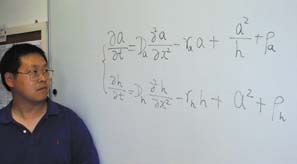|
A
mathematical understanding of how spots and stripes occur on seashells,
fish and elsewhere in nature has been the work of researchers at The Chinese
University of Hong
Kong.

Prof Wei and
the equation that can predict stripes and spots on seashells |
Using
a system based on the reaction of two types of bio-chemicals, activators
and inhibitors, the researchers found they could predict patterns in nature
to a high degree of accuracy. Principal Investigator, Prof Jun-cheng Wei,
said they are also able to compute random, non-uniform patterns.
 Premise of
the research stems from the 1950s and an idea by founding father of computer
science, Alan Turing. Premise of
the research stems from the 1950s and an idea by founding father of computer
science, Alan Turing.
 He proposed
that patterns in nature could be predicted based on the fact that activators
diffuse much faster than inhibitors. The idea was only verified mathematically
in the 90s He proposed
that patterns in nature could be predicted based on the fact that activators
diffuse much faster than inhibitors. The idea was only verified mathematically
in the 90s
 Said
Prof Wei: “The research is important to our understanding of basic
science. We are among world leaders in this field.” Said
Prof Wei: “The research is important to our understanding of basic
science. We are among world leaders in this field.”
 In a follow-on
project, Prof Wei is looking at pattern formation in polymers with findings
having possible commercial uses in a variety of industries from aerospace
to toys. In a follow-on
project, Prof Wei is looking at pattern formation in polymers with findings
having possible commercial uses in a variety of industries from aerospace
to toys.
Principal Investigator
Prof Jun-cheng Wei: wei@math.cuhk.edu.hk

|

![]()

![]()